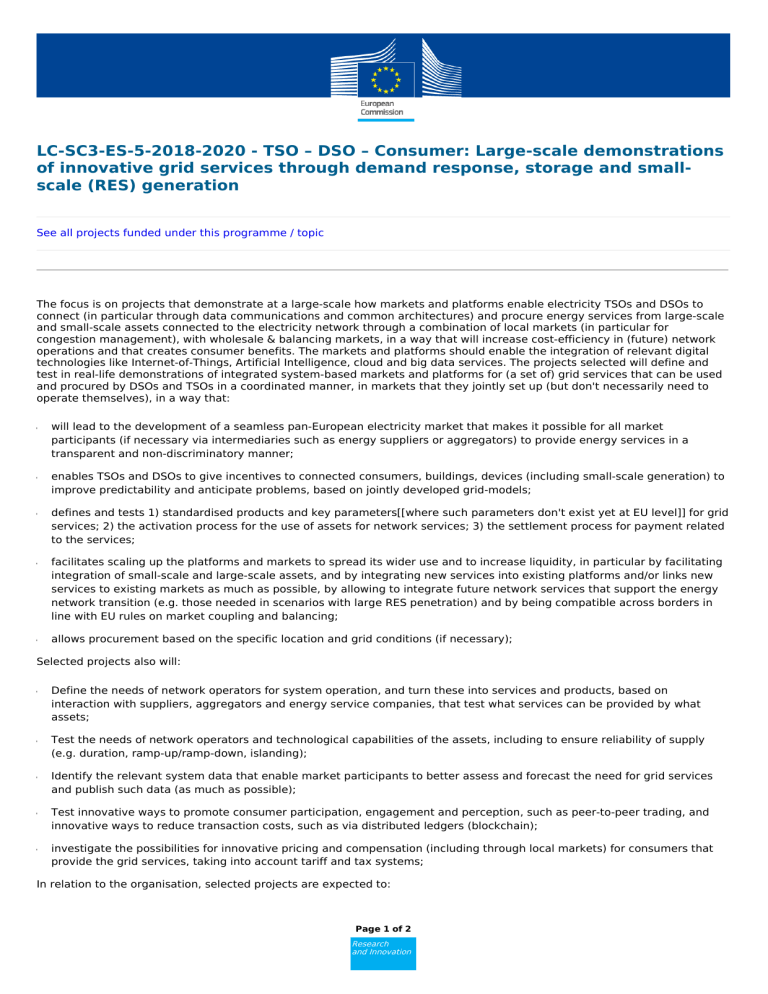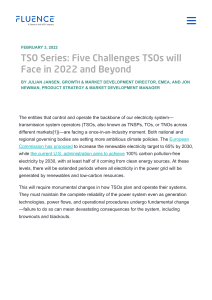
LC-SC3-ES-5-2018-2020 - TSO – DSO – Consumer: Large-scale demonstrations of innovative grid services through demand response, storage and smallscale (RES) generation See all projects funded under this programme / topic The focus is on projects that demonstrate at a large-scale how markets and platforms enable electricity TSOs and DSOs to connect (in particular through data communications and common architectures) and procure energy services from large-scale and small-scale assets connected to the electricity network through a combination of local markets (in particular for congestion management), with wholesale & balancing markets, in a way that will increase cost-efficiency in (future) network operations and that creates consumer benefits. The markets and platforms should enable the integration of relevant digital technologies like Internet-of-Things, Artificial Intelligence, cloud and big data services. The projects selected will define and test in real-life demonstrations of integrated system-based markets and platforms for (a set of) grid services that can be used and procured by DSOs and TSOs in a coordinated manner, in markets that they jointly set up (but don't necessarily need to operate themselves), in a way that: will lead to the development of a seamless pan-European electricity market that makes it possible for all market participants (if necessary via intermediaries such as energy suppliers or aggregators) to provide energy services in a transparent and non-discriminatory manner; enables TSOs and DSOs to give incentives to connected consumers, buildings, devices (including small-scale generation) to improve predictability and anticipate problems, based on jointly developed grid-models; defines and tests 1) standardised products and key parameters[[where such parameters don't exist yet at EU level]] for grid services; 2) the activation process for the use of assets for network services; 3) the settlement process for payment related to the services; facilitates scaling up the platforms and markets to spread its wider use and to increase liquidity, in particular by facilitating integration of small-scale and large-scale assets, and by integrating new services into existing platforms and/or links new services to existing markets as much as possible, by allowing to integrate future network services that support the energy network transition (e.g. those needed in scenarios with large RES penetration) and by being compatible across borders in line with EU rules on market coupling and balancing; allows procurement based on the specific location and grid conditions (if necessary); Selected projects also will: Define the needs of network operators for system operation, and turn these into services and products, based on interaction with suppliers, aggregators and energy service companies, that test what services can be provided by what assets; Test the needs of network operators and technological capabilities of the assets, including to ensure reliability of supply (e.g. duration, ramp-up/ramp-down, islanding); Identify the relevant system data that enable market participants to better assess and forecast the need for grid services and publish such data (as much as possible); Test innovative ways to promote consumer participation, engagement and perception, such as peer-to-peer trading, and innovative ways to reduce transaction costs, such as via distributed ledgers (blockchain); investigate the possibilities for innovative pricing and compensation (including through local markets) for consumers that provide the grid services, taking into account tariff and tax systems; In relation to the organisation, selected projects are expected to: Page 1 of 2 Research and Innovation Make use of cascading funds for the incorporation of developers of innovative energy services (in particular for household consumers) by SME’s. Coordinate their work with NRA's, ENTSO-E, the DSO organisations and other stakeholders and take into account the experience from other projects through cooperation in the BRIDGE initiative[[http://www.h2020-bridge.eu/]]and work with Digitisation of Energy projects, funded under the following topics: SU-DS04-2018-2020: Cybersecurity in the Electrical Power and Energy System (EPES): an armour against cyber and privacy attacks; DT-ICT-10-2018: Interoperable and smart homes and grids; DT-ICT-11-2019: Big data solutions for energy. as well as with the projects funded under topic LC-SC3-EE-13-2018-2019-2020:Enabling next-generation of smart energy services valorising energy efficiency and flexibility at demand-side as energy resource where innovative consumer energy services will be developed and tested regarding their business viability and consumer acceptance. TRL will range typically between 5 and 8 (see part G of the General Annexes). Proposals should comply with the requirements stated in the section 'Common requirements' of the introduction to the part on the Smart citizen-centred energy system. The Commission considers that proposals requesting a contribution from the EU of between EUR 13 to 17 million would allow this specific challenge to be addressed appropriately. Nonetheless, this does not preclude submission and selection of proposals requesting other amounts. The legislative proposals on the energy market that the Commission adopted on 30 November 2016 (the so-called winter package), in particular the Electricity Directive, promotes that network operators procure balancing, congestion management and ancillary services from assets connected to the network both at transmission and at distribution level, based on cooperation among them.[[ see a.o. the proposed Guideline on Electricity Balancing, Article 32 of the proposal for a Directive on the internal electricity market, COM(2016)864, 2016/0380(COD), Article 53 of the proposal for a Regulation on the internal electricity market, COM(2016)861, 2016/0379(COD)]] This will enable more efficient and effective network management and optimisation, for the benefit of increased demand response and the ability to integrate increasing shares of renewables. TSOs and DSOs will use the same pool of resources: actions by both can mutually affect each other. In cooperation with market participants, they have to define the services they want to procure, and have to set up ways to procure them in a coordinated manner. Solutions will contribute to a smart, secure and more resilient energy system through demonstrating cost-efficient model(s) for electricity network services that can be scaled up to include networks operated by other TSOs and DSOs, and that will be replicable across the EU energy system and provide the foundations for new network codes, particularly on demand-response. In so doing they will contribute to opening up significant new revenue streams for consumers to provide grid services, and increase the share of RES in the electricity system. Last updated on 2019-04-16 Retrieved on 2019-11-19 Permalink: https://cordis.europa.eu/programme/rcn/704427_en.html © European Union, 2019 Page 2 of 2 Research and Innovation



